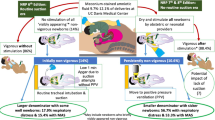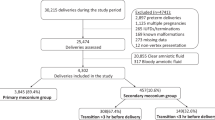Abstract
OBJECTIVE:
To study the impact of neonatal resuscitation program (NRP) guidelines on delivery room (DR) management of infants born through meconium-stained amniotic fluid (MSAF).
STUDY DESIGN:
A retrospective study of all term (≥37 weeks) infants born through MSAF was performed. Patients were divided into two periods: pre year 2000 NRP and post year 2000 NRP. Meconium consistency, APGAR scores and intubation (INT) for suctioning and respiratory outcome were recorded. Groups were analyzed using χ2 tests and stepwise logistic regression.
RESULTS:
The incidence of MSAF remained constant in period 1 (13.6%) and period 2 (13.1%) while the proportion of infants intubated fell from 67 to 41% (p<0.001). The incidence of meconium aspiration and nonspecific respiratory distress did not differ between groups.
CONCLUSIONS:
Since the implementation of year 2000 NRP guidelines, the rate of DR INT for tracheal suctioning has fallen significantly without a change in overall respiratory complications. Results of this study support the efficacy of year 2000 NRP recommendations.
This is a preview of subscription content, access via your institution
Access options
Subscribe to this journal
Receive 12 print issues and online access
$259.00 per year
only $21.58 per issue
Buy this article
- Purchase on Springer Link
- Instant access to full article PDF
Prices may be subject to local taxes which are calculated during checkout


Similar content being viewed by others
References
Wiswell TE, Gannon CM, Jacob J, et al. Delivery room management of the apparently vigorous meconium stained neonate: results of the multicenter, international collaborative trial. Pediatrics 2000;105:1–7.
Linder M, Aranda JV, Tsur M, et al. Need for endotracheal intubation and suction in meconium stained neonates. J Pediatr 1988;112 (4):613–615.
Avery GB, Fletcher MA, MacDonald MG . Textbook of Neonatology: Pathophysiology and Management of the Newborn 1999. 5th Edition. p 494–495.
Cleary GM, Wiswell TE . Meconium stained amniotic fluid and the meconium aspiration syndrome: an update. Pediatr Clin N Am 1998;45:511–529.
Gelfand SL, Fanaroff JM, Walsh MC . Meconium stained fluid: approach to the mother and the baby. Pediatr Clin N Am 2004;51 (3):655–667.
Wiswell TE, Bent RC . Meconium staining and meconium aspiration syndrome: unresolved issues. Pediatr Clin N Am 1993;40:955–971.
Niermeyer S, Kattwinkel J, Van Reempts P . International guidelines for neonatal resuscitation: an excerpt from the guidelines 2000 for cardiopulmonary resuscitation and emergency cardiovascular care: International Consensus on Science. Contributors and reviewers for the neonatal resuscitation guidelines. Pediatrics 2000;106 (3):E29.
Kattwinkel J, Short J, Niermeyer S, et al. Neonatal Resuscitation Textbook. 4th ed. American Academy of Pediatrics and American Heart Association, Elk Grove Village, IL: 2000.
Carson BS, Losey RW, Bowes Jr WA, Simmons MA . Combined pediatric and obstetric approach to prevent meconium aspiration syndrome. Am J Obstet Gynecol 1976;126:712–715.
Ting P, Brady JP . Tracheal suction in meconium aspiration. Am J Obstet Gynecol 1975;122 (6):767–771.
Bent RC, Wiswell TE, Chang A . Removing meconium from infant trachea. What works best? Am J Dis Child 1992;146:1084–1088.
Manganaro R, Mami C, Palmara A . Incidence of meconium aspiration syndrome in term meconium stained babies managed at birth with selective tracheal intubation. J Perinatol Med 2001;29:465–468.
Yoder BA, Kirsch EA, Barth WH, Gordon MC . Changing obstetric practice associated with decreasing incidence of meconium aspiration syndrome. Obstet Gynecol 2002;99:731–739.
Alwood AL, Madar RJ, Baumer JH, Readdy L, Wright D . Changes in resuscitation practice at birth. Arch Dis Child Fetal Neonatal Ed 2003;88:F375–F379.
Chaturvedi P, Yadav B, Bharambe MS . Delivery room management of neonates born through meconium stained amniotic fluid. Indian Pediatr 2000;37:1251–1255.
Liu WF, Harrington T . The need for delivery room intubation of thin meconium in the low-risk newborn: a clinical trial. Am J Perinatol 1998;15 (12):675–682.
Daga SR, Dave K, Mehta V . Tracheal suction in meconium stained infants: a randomized controlled study. J Trop Med 1994;40:198–200.
Gupta V, Bhatia BD, Mishra OP . Meconium stained amniotic fluid: antenatal, intrapartum, and neonatal attributes. Indian Pediatr 1996;33:293–297.
Peng TC, Gutcher GR, Van Dorsten JP . A selective aggressive approach to the neonate exposed to meconium-stained amniotic fluid. Am J Obstet Gynecol 1996;175:296–301.
Yoder BA . Meconium-stained amniotic fluid and respiratory complications: impact of selective tracheal suction. Obstet Gynecol 1994;83:77–84.
Halliday HL . Endotracheal intubation at birth for preventing morbidity and mortality in vigorous, meconium stained infants born at term. Cochrane Database Syst Rev 2000;2:CD 000500.
Acknowledgements
We thank the mid-level practitioners and pediatric residents at Connecticut Children's Medical Center whose documentation of DR resuscitations made this study possible.
Author information
Authors and Affiliations
Rights and permissions
About this article
Cite this article
Kabbur, P., Herson, V., Zaremba, S. et al. Have the Year 2000 Neonatal Resuscitation Program Guidelines Changed the Delivery Room Management or Outcome of Meconium-Stained Infants?. J Perinatol 25, 694–697 (2005). https://doi.org/10.1038/sj.jp.7211385
Published:
Issue Date:
DOI: https://doi.org/10.1038/sj.jp.7211385
This article is cited by
-
Global report on preterm birth and stillbirth (3 of 7): evidence for effectiveness of interventions
BMC Pregnancy and Childbirth (2010)



